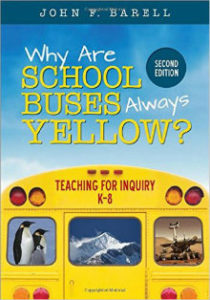A Guide to Creating an Inquiry Classroom
Why Are School Buses Always Yellow? Teaching for Inquiry K-8, 2nd Edition
By John F. Barell
(Corwin, 2016 – Learn more)

Why are the birds flying away? Where did the rain go? Remember those countless questions two-year-olds ask? As children grow up, these questions often get stifled in the classroom and home. Often these questions at home are replaced with homework. The questions at school are replaced with constant curriculum demands.

This book is designed to challenge students to become more deeply engaged in their learning and to be H.O.T. Students (Higher Order Thinking Students). It’s the type of book that is written to give them responsibility for their own learning.
A curious author
Barell is no stranger to inquiry. After reading Richard E. Byrd’s book Little America as a teenager, he was inspired to contact Admiral Byrd, who later invited him to explore Antarctica…which he did. He’s the Professor Emeritus of Curriculum and Teaching at Montclair State University and a former public school teacher. In addition, Barell served as a consultant to the American Museum of Natural History in New York City, aiding teachers and students in their pursuit to ask questions and have them answered.
The first edition of his book inspired teachers, administrators, and students. The second edition, which includes updates based on the latest research around inquiry-based teaching, is sure to continue to inspire young minds to think beyond the text, to ask questions, and to wonder.
Building questioning skills
This book is promoting a question-friendly classroom and developing deeper questions and questioning skills, something we all can benefit from. I am reminded of a recent language arts unit of study. Students were researching the colonial period of history in America. While discussing possible topics, some students wondered if their research could be about a topic they had previously researched in third grade. (That was a hmmm moment!)
After being encouraged to seek out topics they were interested in, but not their “expertise”(researched in third grade), they began to investigate the time period and develop questions. At first, many of the questions were very simplistic such as: Where did they live? What did the kids do all day? What did they hunt? After several strategic mini lessons and some modeling, their questions became more developed.
As I conferred with the research teams, I heard many exchanges of information and more questions were asked. The discussion weren’t just about facts, but the “What if’s…Why?” Powerful!
The power of modeling
This book is a powerful reminder to all adults of the importance of modeling the inquiry process with children. Model both the asking of questions and the search for answers (not just in Wikipedia).
Think about it: we model how to become more strategic readers and writers. We model how to ask questions about math problems in order to understand how to solve them. We ask questions in science class. But many of these question-asking tasks are ones where the answer is in the text or “discovered” after following calculated steps in a science experiment. This book helps you become a better model of inquiry.
Students (and teachers) need to practice the art of inquiry. Practice, because it usually doesn’t come naturally. When taking a walk up a mountain, look around you and ask questions. Think about the early settlers and how they forged through the forests and mountain trails. Ask yourself about how they might have felt, questions they might have puzzled over as they explored their environment.
The new edition’s helpful organization
I like how the book is organized in the second edition. The first chapter deals with a refined definition of inquiry based instruction, including examples. Chapter Two follows with the rationale for inquiry in the classroom.
Chapter Three helps the teacher understand how to begin the shift toward inquiry-based learning, while Chapter Four guides the teacher on how to reshape her approach to the curriculum (yes, you can cover the curriculum and do inquiry based instruction at the same time!). Chapter Five answers the first question about a inquiry-based classroom – “When is it chaos?” by considering who controls the decision making process and how we give students responsibility.
Chapter Six is all about asking the right kinds of questions, while Chapter Seven examines how we know whether the students are advancing in their ability to ask higher level questions. This chapter is valuable to the teacher and the student.
The uses of technology and how to critically access and analyze it are the subjects of Chapter Eight. Families need to be involved, and getting families to become more inquisitive is the subject of Chapter Nine. Chapter Ten offers new research to aid the teacher. And the book concludes with Chapter Eleven, exploring how to use social media and professional development in today’s busy teaching world.
A lively, helpful read
This is not just a text to read, but a text to fill with sticky notes, bookmarking pages and activities. Barell’s experience as an educator, speaker, and inquisitive thinker makes his prose come alive. The book teaches and helps teachers see how we can actually accomplish inquiry based instruction while also teaching the curriculum and meeting the standards.
It is a book that prepares our students for 21st century careers and college readiness in a world that will surely be filled with questions that need answering.
Linda Biondi is a fourth grade teacher at Sharon Elementary School in Robbinsville, NJ and a long-time Morning Meeting practitioner. She’s also the recipient of several educational grants, a Teacher Consultant with the National Writing Project, and a participant on the NJ Department of Education Teacher Advisory Panel and with ECET2 Celebrate Teaching.


































